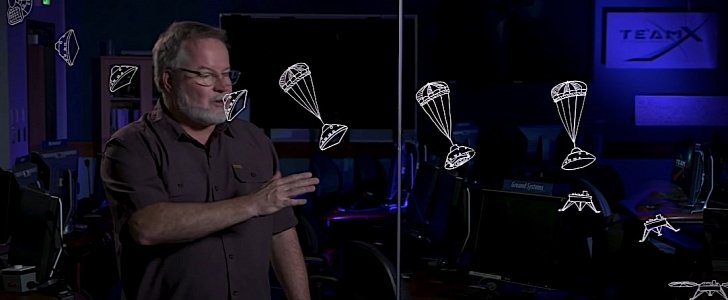Most of you know by now that today is a special day for both the American and European space agencies, as the InSight spacecraft is quickly approaching the moment when it will descend on the Elysium Planitia and begin its literally groundbreaking work.
Over the past few weeks, NASA has been busy trying to let the world know how difficult the Mars landings usually are, but up until now we only marginally could imagine it. Thanks to a new video NASA made public this weekend, it all becomes much clearer.
A short, 3-minute video narrated by Rob Manning, chief engineer at the Jet Propulsion Laboratory, shows the many stages and steps the InSight will have to make just right for the spacecraft to land successfully on the planet.
The combo of thousands of steps to be made by InSIght starts with just seven minutes before it reaches the top of the Martian atmosphere, when the cruise stage gets separated.
The capsule carrying InSight will then have to get in position so that its heat shield is facing the atmosphere. Moving at over 20,000 km/h (13,000 mph), the ship will have to dive in at an angle of 12 degrees to avoid either burning up or skipping off the top of the atmosphere.
As it enters, the deceleration is of about 12 Earth G, slowing the ship down to only 1,600 km/h (1,000 mph) in a very short period of time.
At an altitude of 10 miles above the surface, a parachute will be deployed to further trims some excess speed. The heat shield then gets blown away via explosive devices, 15 seconds after the chute inflates.
Ten seconds after losing its heat shield, InSight will be extending its landing legs. 60 seconds after that, a radar comes on, allowing the spacecraft to see how far up it is from the ground and how fast it is traveling.
When the one-mile high mark is reached, the back shell detaches, leaving the InSIght lander to fall to the ground on its own.
InSIght is equipped with an engine which will kick in as soon as begins free falling, and will have to use them to move out of the way of the incoming back shell. It will then have to turn them off the instant it hits solid ground. Otherwise it might topple over.
Once on the ground, the lander will begin its two-year mission of looking at how Mars was formed.
Below is the full three-minute video of this Mars landing guide for dummies. Enjoy.
A short, 3-minute video narrated by Rob Manning, chief engineer at the Jet Propulsion Laboratory, shows the many stages and steps the InSight will have to make just right for the spacecraft to land successfully on the planet.
The combo of thousands of steps to be made by InSIght starts with just seven minutes before it reaches the top of the Martian atmosphere, when the cruise stage gets separated.
The capsule carrying InSight will then have to get in position so that its heat shield is facing the atmosphere. Moving at over 20,000 km/h (13,000 mph), the ship will have to dive in at an angle of 12 degrees to avoid either burning up or skipping off the top of the atmosphere.
As it enters, the deceleration is of about 12 Earth G, slowing the ship down to only 1,600 km/h (1,000 mph) in a very short period of time.
At an altitude of 10 miles above the surface, a parachute will be deployed to further trims some excess speed. The heat shield then gets blown away via explosive devices, 15 seconds after the chute inflates.
Ten seconds after losing its heat shield, InSight will be extending its landing legs. 60 seconds after that, a radar comes on, allowing the spacecraft to see how far up it is from the ground and how fast it is traveling.
When the one-mile high mark is reached, the back shell detaches, leaving the InSIght lander to fall to the ground on its own.
InSIght is equipped with an engine which will kick in as soon as begins free falling, and will have to use them to move out of the way of the incoming back shell. It will then have to turn them off the instant it hits solid ground. Otherwise it might topple over.
Once on the ground, the lander will begin its two-year mission of looking at how Mars was formed.
Below is the full three-minute video of this Mars landing guide for dummies. Enjoy.


